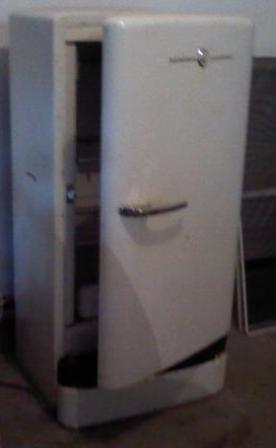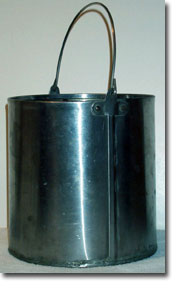
Recently in History Category

Col.
George Washington's Small Beer (1737)
To Make
Small Beer
Take a
large Siffer [Sifter] full of Bran Hops to your Taste. - Boil
these 3
hours then strain out 30 Gall[ons] into a cooler put in 3 Gall[ons]
Molasses
while the Beer is Scalding hot or rather draw the Melasses
into the
cooler & St[r]ain the Beer on it while boiling Hot. let this
stand
till it is little more than Blood warm then put in a quart of
Yea[s]t
if the Weather is very Cold cover it over with a Blank[et] &
let it
Work in the Cooler 24 hours then put it into the Cask - leave
the bung
open till it is almost don[e] Working - Bottle it that
day Week
it was Brewed.
Benjamin
Franklin's Spruce Beer
For a
Cask containing 80 bottles, take one pot of Essence and 13
Pounds of
Molases. - or the same amount of unrefined Loaf Sugar;
mix them
well together in 20 pints of hot Water: Stir together until
they make
a Foam, then pour it into the Cask you will then fill with
Water:
add a Pint of good Yeast, stir it well together and let it stand 2
or 3 Days
to ferment, after which close the Cask, and after a few days
it will
be ready to be put into Bottles, that must be tightly corked.
Leave
them 10 or 12 Days in a cool Cellar, after which the Beer will
be good
to drink.
The history of brewing stretches back thousands of years. Cuneiform tablets have been found in the territory of the ancient Sumerians in Mesopotamia indicating that beer was available there as early as the third millennium B.C.E.
In ancient Egypt, brewing was widespread, and beer was a favorite beverage. Archaeological excavations there revealed the oldest written recipe for the brewing of beer. Babylonians too had beer.
Historians speculate that prehistoric nomads may have made beer from grain and water before learning to make bread.
The origin of the English word 'beer' is interesting. You have the English word 'bere', the Latin 'bibere' and the German 'bior'. All possible places of origin. Perhaps the word is much older than we think. The origin of the word 'ale' is just about as hard to pin down. One thing is for sure it has continued to be popular for a few thousand years.
It seems that all around the world people have been making beer for a very long time. Not just from Barley. Corn, and many other grains have been used.
During the Middle Ages in Europe, the brewing of beer moved to the monasteries. European monks improved the technology of the process, using hops as a preservative. Industrialization in the 19th century brought in the mechanization of brewing and proved to be a milestone in the history of this popular drink.
In the years to come man learned more about yeast and how it worked. This paved the way for better beer making techniques.
All this said making beer is still an art.
Archaeologists
working in southern Peru found an ancient brewery more than 1,000 years old.
Remains of the brewing facility were uncovered on Cerro Baúl, a mountaintop
city over 8,000 feet above sea level, which was home to elite members of the
Wari Empire from AD 600-1000.
Predating
the Inca Empire by at least four centuries, this Wari brewery was used to make
chicha, a fermented beverage similar to beer that played an important role in
ritual feasting and drinking during Peru's first empire. Ancient Peruvians made
chicha with local grains and fruit, which is quite different from today's
commercial beers typically made with barley and hops.
Carolyn
from Bella Online shares her thoughts about tavern limericks. The following
three are from her article.
There was
a sweet girl from Gadzooks
Who spent
all her time coaching crooks-
As
thieves they had fun
And she
needed no gun
'Cause
she'd just knock 'em dead with her looks.
There was
a weight trainer named Joe
Had a
voice that was sexy and low -
He
attracted a lass
With his
muscular ass
And a bag
overflowing with dough.
There was
a park ranger named Dale
Who liked
making moonshine and ale-
He first
filled a mug
But drank
the whole jug
Then
passed out and drowned in his pail.
My
favorite limerick is "A Barmaid From Sale"
On the
chest of a barmaid in Sale
Were
tattooed the prices of ale.
And on
her behind,
For the
sake of the blind,
Was the
same information in Braille.
The
limerick also known as nonsense verse is a popular form of short, humorous
verse that is often nonsensical and frequently ribald. It consists of five
lines, rhyming aabba, the first, second, and fifth lines must have three
accented beats in them. The third and fourth lines must have two accented
beats.
The
origin of the limerick is unknown, but it has been suggested that the name
derives from the chorus of an 18th-century Irish soldiers' song, "Will You Come
Up to Limerick?"
Here is
another theory as to origin of the Limerick.
Preface:
It amazes
me that although events that took place in the past are completely finite and
unchangeable, history seems to have a lot of versions. It is often
intentionally or unintentionally mudded and clouded, a virtual maze for anyone
trying to find real answers.
It seems
that one is generally met with this constant of history when researching
anything that took place in the past. The history of brewing is no exception.
The
History and Origin of the Brewers Star
Brewers
as far back as the 1300's painted a six-pointed star on the ends of their beer
kegs, known as the "brewer's star". The star was the official insignia of the
Brewer's Guild as early as the 1500s. The star was hung outside breweries and
incorporated into logos for breweries and can still be seen in small village
breweries in Bavaria.
Apparently
the brewer's star was intended to symbolize purity. If a brewer attached this
insignia to his brew he was in essence declaring it to be free of any
impurities such as additives, and adjuncts. In folklore the six points of the
star represented the six aspects of brewing most critical to purity: the water,
the hops, the grain, the malt, the yeast, and the brewer.
Because
of its similarities to the Star of David, some have suggested that King David
was a brewer and this was its origin. According to scripture David was a worshipper of the true
God Jehovah, and the six sided star or hexagram had connections far from true
worship. I am not enough of a historian to know how intermixed the Israelite's were with paganism at this time.
Around
804 B.C.E a possible Biblical reference to this 'star' appears. It can be found
in the Bible at Amos 5:26, where it mentions "the star of YOUR god" making
reference to a pagan god, Rephan also known as Kaiwan. J. A. Hort remarked: "In
the LXX of Am v 26 the form used is [Rhai•phan´] or [Rhe•phan´], which is
similar to Repa or Repha, one of the names of the Egyptian Saturn (Seb)."--The
New Testament in the Original Greek, by Westcott and Hort, Graz, 1974, Vol. II,
appendix, p. 92
Possibly
connected with star worship, the hexagram no doubt existed even long before 804
B.C.E. People in the occult, astrology, and witchcraft have all long used this
symbol. It's often used as a talisman or charm.
Some have
suggested that this found it's way into the Jewish community when Israel's king
Solomon apostatized and started worshiping pagan gods. While others state that
the first use of the term "Shield of David" was about 1300 CE when a Spanish
practitioner of Jewish mysticism wrote a commentary on the central book of that
mysticism, the Zohar. They also state that the first actual linkage of the
hexagram to a Jewish community appears in the early 1300s on the flag of the
Jewish community of Prague, which was designed with permission of Charles IV
when he became king of Bohemia.
So, at
what point did this star find its way into brewing?
That is a pretty good question. I think most answers are going to be pretty speculative. I can see why someone may have wanted to put a symbol of 'good luck' on their brew, much as Bacardi does with the bat emblem. I can also see how if this was an official flag in part of Bohemia, the birthplace of Pilsner, that somehow this star could have come to represent their product. But like I said at the beginning when trying to find answers in History one often finds 'mudded and clouded' answers.
Although
the exact etymology of the word growler, is a little unclear, it's 19th century
to current history is interesting. Growlers or half gallon glass jugs are
popular with local microbreweries as a way to sell 'take home' beer. Back in
the 19th century parents would at dinnertime send their child to a local bar or
brewery to fetch beer in a pail, or covered bucket, which was referred to as a
"growler."
Brander
Matthews wrote about it in Harper's Magazine in July 1893: "In New York a can
brought in filled with beer at a bar-room is called a growler, and the act of
sending this can from the private house to the public-house and back is called
working the growler".
It was
also called rushing the growler, since perhaps these children were often in a
hurry. Teenagers could make good money and get a free lunch if they would show
up at the factories and pick up the workers' beer pails to get them filled  at
the taverns. They would sometime use a long pole in order to carry a quantity
of pails to refill on one trip. Another possible explanation for using the term
'rushing' the growler.
at
the taverns. They would sometime use a long pole in order to carry a quantity
of pails to refill on one trip. Another possible explanation for using the term
'rushing' the growler.
Regarding
the term 'growler the Trenton Times for 20 June 1883 said, perhaps in jest "It
is called the growler because it provokes so much trouble in the scramble after
beer"
One can
only imagine that if you spilt your fathers can of Ale that he was the growler.
It seems that it may have been a slang term, and those who "rushed the growler"
were no doubt the poorer working class looked down upon by the upper crust of
society.
It reminds me of the part in John Barleycorn where he says "It was on a hot day, and my father was ploughing in the field. I was sent from the house, half a mile away, to carry to him a pail of beer".
This is a
pretty cool article. I have to disagree with his statement: "I don't think a
brewery rises to the level of an 1812 fort.""
Old
foundations are exposed all the time as
So I
decided to ask Miller about it. Here is what they said:
"We do
not comment on any future promotions, advertising ideas,
commercials,
products,
etc. until they are released to the general public.
We
appreciate your interest in our company.
Cheers!"